Fang Li
University of Texas at Dallas
Tensor Completion via Monotone Inclusion: Generalized Low-Rank Priors Meet Deep Denoisers
Oct 14, 2025Abstract:Missing entries in multi dimensional data pose significant challenges for downstream analysis across diverse real world applications. These data are naturally modeled as tensors, and recent completion methods integrating global low rank priors with plug and play denoisers have demonstrated strong empirical performance. However, these approaches often rely on empirical convergence alone or unrealistic assumptions, such as deep denoisers acting as proximal operators of implicit regularizers, which generally does not hold. To address these limitations, we propose a novel tensor completion framework grounded in the monotone inclusion paradigm, which unifies generalized low rank priors with deep pseudo contractive denoisers and extends beyond traditional convex optimization. Building on the Davis Yin splitting scheme, we develop the GTCTV DPC algorithm and rigorously establish its global convergence. Extensive experiments demonstrate that GTCTV DPC consistently outperforms existing methods in both quantitative metrics and visual quality, particularly at low sampling rates.
RGB-Only Supervised Camera Parameter Optimization in Dynamic Scenes
Sep 18, 2025

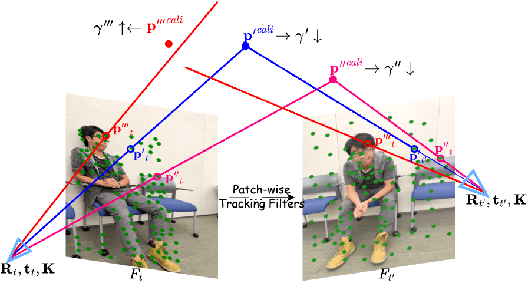
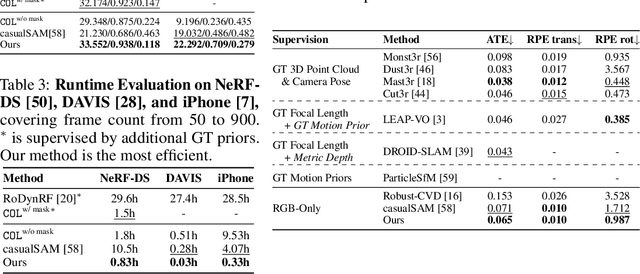
Abstract:Although COLMAP has long remained the predominant method for camera parameter optimization in static scenes, it is constrained by its lengthy runtime and reliance on ground truth (GT) motion masks for application to dynamic scenes. Many efforts attempted to improve it by incorporating more priors as supervision such as GT focal length, motion masks, 3D point clouds, camera poses, and metric depth, which, however, are typically unavailable in casually captured RGB videos. In this paper, we propose a novel method for more accurate and efficient camera parameter optimization in dynamic scenes solely supervised by a single RGB video. Our method consists of three key components: (1) Patch-wise Tracking Filters, to establish robust and maximally sparse hinge-like relations across the RGB video. (2) Outlier-aware Joint Optimization, for efficient camera parameter optimization by adaptive down-weighting of moving outliers, without reliance on motion priors. (3) A Two-stage Optimization Strategy, to enhance stability and optimization speed by a trade-off between the Softplus limits and convex minima in losses. We visually and numerically evaluate our camera estimates. To further validate accuracy, we feed the camera estimates into a 4D reconstruction method and assess the resulting 3D scenes, and rendered 2D RGB and depth maps. We perform experiments on 4 real-world datasets (NeRF-DS, DAVIS, iPhone, and TUM-dynamics) and 1 synthetic dataset (MPI-Sintel), demonstrating that our method estimates camera parameters more efficiently and accurately with a single RGB video as the only supervision.
Kimi K2: Open Agentic Intelligence
Jul 28, 2025Abstract:We introduce Kimi K2, a Mixture-of-Experts (MoE) large language model with 32 billion activated parameters and 1 trillion total parameters. We propose the MuonClip optimizer, which improves upon Muon with a novel QK-clip technique to address training instability while enjoying the advanced token efficiency of Muon. Based on MuonClip, K2 was pre-trained on 15.5 trillion tokens with zero loss spike. During post-training, K2 undergoes a multi-stage post-training process, highlighted by a large-scale agentic data synthesis pipeline and a joint reinforcement learning (RL) stage, where the model improves its capabilities through interactions with real and synthetic environments. Kimi K2 achieves state-of-the-art performance among open-source non-thinking models, with strengths in agentic capabilities. Notably, K2 obtains 66.1 on Tau2-Bench, 76.5 on ACEBench (En), 65.8 on SWE-Bench Verified, and 47.3 on SWE-Bench Multilingual -- surpassing most open and closed-sourced baselines in non-thinking settings. It also exhibits strong capabilities in coding, mathematics, and reasoning tasks, with a score of 53.7 on LiveCodeBench v6, 49.5 on AIME 2025, 75.1 on GPQA-Diamond, and 27.1 on OJBench, all without extended thinking. These results position Kimi K2 as one of the most capable open-source large language models to date, particularly in software engineering and agentic tasks. We release our base and post-trained model checkpoints to facilitate future research and applications of agentic intelligence.
Compositional Function Networks: A High-Performance Alternative to Deep Neural Networks with Built-in Interpretability
Jul 28, 2025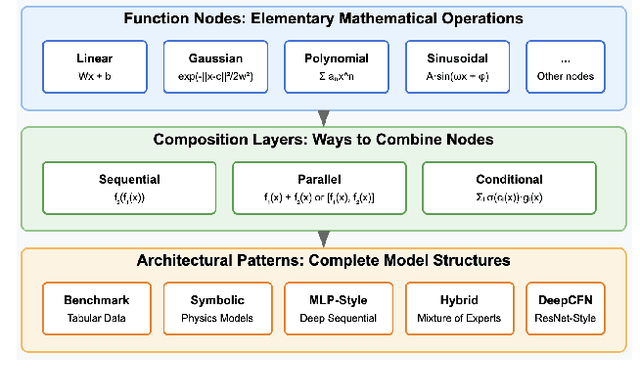
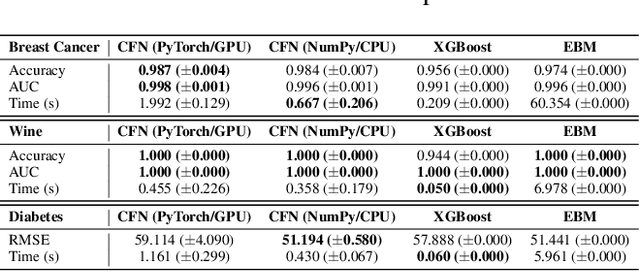
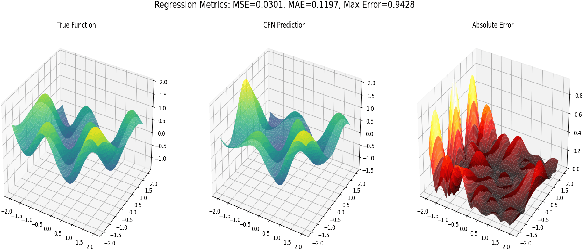

Abstract:Deep Neural Networks (DNNs) deliver impressive performance but their black-box nature limits deployment in high-stakes domains requiring transparency. We introduce Compositional Function Networks (CFNs), a novel framework that builds inherently interpretable models by composing elementary mathematical functions with clear semantics. Unlike existing interpretable approaches that are limited to simple additive structures, CFNs support diverse compositional patterns -- sequential, parallel, and conditional -- enabling complex feature interactions while maintaining transparency. A key innovation is that CFNs are fully differentiable, allowing efficient training through standard gradient descent. We demonstrate CFNs' versatility across multiple domains, from symbolic regression to image classification with deep hierarchical networks. Our empirical evaluation shows CFNs achieve competitive performance against black-box models (96.24% accuracy on CIFAR-10) while outperforming state-of-the-art interpretable models like Explainable Boosting Machines. By combining the hierarchical expressiveness and efficient training of deep learning with the intrinsic interpretability of well-defined mathematical functions, CFNs offer a powerful framework for applications where both performance and accountability are paramount.
ReCogDrive: A Reinforced Cognitive Framework for End-to-End Autonomous Driving
Jun 09, 2025Abstract:Although end-to-end autonomous driving has made remarkable progress, its performance degrades significantly in rare and long-tail scenarios. Recent approaches attempt to address this challenge by leveraging the rich world knowledge of Vision-Language Models (VLMs), but these methods suffer from several limitations: (1) a significant domain gap between the pre-training data of VLMs and real-world driving data, (2) a dimensionality mismatch between the discrete language space and the continuous action space, and (3) imitation learning tends to capture the average behavior present in the dataset, which may be suboptimal even dangerous. In this paper, we propose ReCogDrive, an autonomous driving system that integrates VLMs with diffusion planner, which adopts a three-stage paradigm for training. In the first stage, we use a large-scale driving question-answering datasets to train the VLMs, mitigating the domain discrepancy between generic content and real-world driving scenarios. In the second stage, we employ a diffusion-based planner to perform imitation learning, mapping representations from the latent language space to continuous driving actions. Finally, we fine-tune the diffusion planner using reinforcement learning with NAVSIM non-reactive simulator, enabling the model to generate safer, more human-like driving trajectories. We evaluate our approach on the planning-oriented NAVSIM benchmark, achieving a PDMS of 89.6 and setting a new state-of-the-art that surpasses the previous vision-only SOTA by 5.6 PDMS.
Learning Cocoercive Conservative Denoisers via Helmholtz Decomposition for Poisson Inverse Problems
May 13, 2025Abstract:Plug-and-play (PnP) methods with deep denoisers have shown impressive results in imaging problems. They typically require strong convexity or smoothness of the fidelity term and a (residual) non-expansive denoiser for convergence. These assumptions, however, are violated in Poisson inverse problems, and non-expansiveness can hinder denoising performance. To address these challenges, we propose a cocoercive conservative (CoCo) denoiser, which may be (residual) expansive, leading to improved denoising. By leveraging the generalized Helmholtz decomposition, we introduce a novel training strategy that combines Hamiltonian regularization to promote conservativeness and spectral regularization to ensure cocoerciveness. We prove that CoCo denoiser is a proximal operator of a weakly convex function, enabling a restoration model with an implicit weakly convex prior. The global convergence of PnP methods to a stationary point of this restoration model is established. Extensive experimental results demonstrate that our approach outperforms closely related methods in both visual quality and quantitative metrics.
Kimi-VL Technical Report
Apr 10, 2025

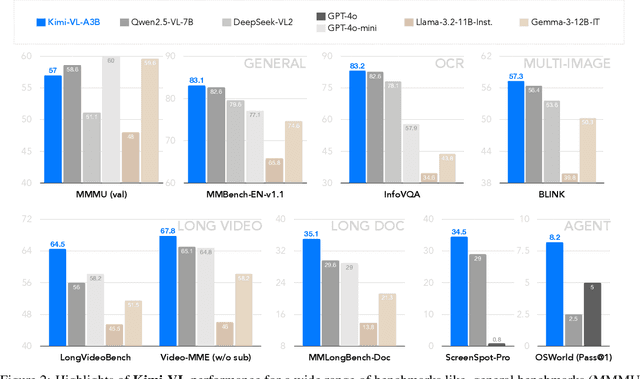

Abstract:We present Kimi-VL, an efficient open-source Mixture-of-Experts (MoE) vision-language model (VLM) that offers advanced multimodal reasoning, long-context understanding, and strong agent capabilities - all while activating only 2.8B parameters in its language decoder (Kimi-VL-A3B). Kimi-VL demonstrates strong performance across challenging domains: as a general-purpose VLM, Kimi-VL excels in multi-turn agent tasks (e.g., OSWorld), matching flagship models. Furthermore, it exhibits remarkable capabilities across diverse challenging vision language tasks, including college-level image and video comprehension, OCR, mathematical reasoning, and multi-image understanding. In comparative evaluations, it effectively competes with cutting-edge efficient VLMs such as GPT-4o-mini, Qwen2.5-VL-7B, and Gemma-3-12B-IT, while surpassing GPT-4o in several key domains. Kimi-VL also advances in processing long contexts and perceiving clearly. With a 128K extended context window, Kimi-VL can process diverse long inputs, achieving impressive scores of 64.5 on LongVideoBench and 35.1 on MMLongBench-Doc. Its native-resolution vision encoder, MoonViT, further allows it to see and understand ultra-high-resolution visual inputs, achieving 83.2 on InfoVQA and 34.5 on ScreenSpot-Pro, while maintaining lower computational cost for common tasks. Building upon Kimi-VL, we introduce an advanced long-thinking variant: Kimi-VL-Thinking. Developed through long chain-of-thought (CoT) supervised fine-tuning (SFT) and reinforcement learning (RL), this model exhibits strong long-horizon reasoning capabilities. It achieves scores of 61.7 on MMMU, 36.8 on MathVision, and 71.3 on MathVista while maintaining the compact 2.8B activated LLM parameters, setting a new standard for efficient multimodal thinking models. Code and models are publicly accessible at https://github.com/MoonshotAI/Kimi-VL.
Sequential-NIAH: A Needle-In-A-Haystack Benchmark for Extracting Sequential Needles from Long Contexts
Apr 09, 2025Abstract:Evaluating the ability of large language models (LLMs) to handle extended contexts is critical, particularly for retrieving information relevant to specific queries embedded within lengthy inputs. We introduce Sequential-NIAH, a benchmark specifically designed to evaluate the capability of LLMs to extract sequential information items (known as needles) from long contexts. The benchmark comprises three types of needle generation pipelines: synthetic, real, and open-domain QA. It includes contexts ranging from 8K to 128K tokens in length, with a dataset of 14,000 samples (2,000 reserved for testing). To facilitate evaluation on this benchmark, we trained a synthetic data-driven evaluation model capable of evaluating answer correctness based on chronological or logical order, achieving an accuracy of 99.49% on synthetic test data. We conducted experiments on six well-known LLMs, revealing that even the best-performing model achieved a maximum accuracy of only 63.15%. Further analysis highlights the growing challenges posed by increasing context lengths and the number of needles, underscoring substantial room for improvement. Additionally, noise robustness experiments validate the reliability of the benchmark, making Sequential-NIAH an important reference for advancing research on long text extraction capabilities of LLMs.
FactGuard: Leveraging Multi-Agent Systems to Generate Answerable and Unanswerable Questions for Enhanced Long-Context LLM Extraction
Apr 08, 2025Abstract:Extractive reading comprehension systems are designed to locate the correct answer to a question within a given text. However, a persistent challenge lies in ensuring these models maintain high accuracy in answering questions while reliably recognizing unanswerable queries. Despite significant advances in large language models (LLMs) for reading comprehension, this issue remains critical, particularly as the length of supported contexts continues to expand. To address this challenge, we propose an innovative data augmentation methodology grounded in a multi-agent collaborative framework. Unlike traditional methods, such as the costly human annotation process required for datasets like SQuAD 2.0, our method autonomously generates evidence-based question-answer pairs and systematically constructs unanswerable questions. Using this methodology, we developed the FactGuard-Bench dataset, which comprises 25,220 examples of both answerable and unanswerable question scenarios, with context lengths ranging from 8K to 128K. Experimental evaluations conducted on seven popular LLMs reveal that even the most advanced models achieve only 61.79% overall accuracy. Furthermore, we emphasize the importance of a model's ability to reason about unanswerable questions to avoid generating plausible but incorrect answers. By implementing efficient data selection and generation within the multi-agent collaborative framework, our method significantly reduces the traditionally high costs associated with manual annotation and provides valuable insights for the training and optimization of LLMs.
TiGDistill-BEV: Multi-view BEV 3D Object Detection via Target Inner-Geometry Learning Distillation
Dec 30, 2024



Abstract:Accurate multi-view 3D object detection is essential for applications such as autonomous driving. Researchers have consistently aimed to leverage LiDAR's precise spatial information to enhance camera-based detectors through methods like depth supervision and bird-eye-view (BEV) feature distillation. However, existing approaches often face challenges due to the inherent differences between LiDAR and camera data representations. In this paper, we introduce the TiGDistill-BEV, a novel approach that effectively bridges this gap by leveraging the strengths of both sensors. Our method distills knowledge from diverse modalities(e.g., LiDAR) as the teacher model to a camera-based student detector, utilizing the Target Inner-Geometry learning scheme to enhance camera-based BEV detectors through both depth and BEV features by leveraging diverse modalities. Specially, we propose two key modules: an inner-depth supervision module to learn the low-level relative depth relations within objects which equips detectors with a deeper understanding of object-level spatial structures, and an inner-feature BEV distillation module to transfer high-level semantics of different key points within foreground targets. To further alleviate the domain gap, we incorporate both inter-channel and inter-keypoint distillation to model feature similarity. Extensive experiments on the nuScenes benchmark demonstrate that TiGDistill-BEV significantly boosts camera-based only detectors achieving a state-of-the-art with 62.8% NDS and surpassing previous methods by a significant margin. The codes is available at: https://github.com/Public-BOTs/TiGDistill-BEV.git.
 Add to Chrome
Add to Chrome Add to Firefox
Add to Firefox Add to Edge
Add to Edge